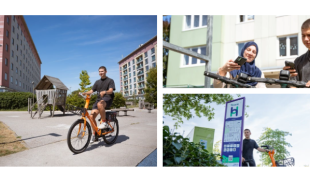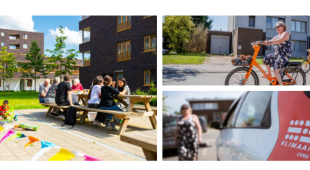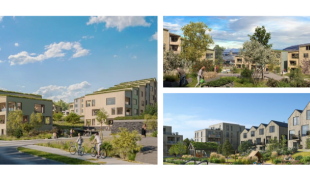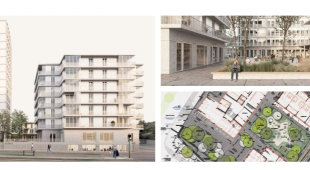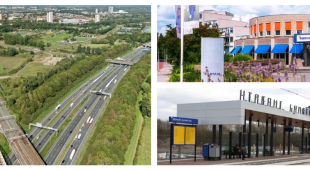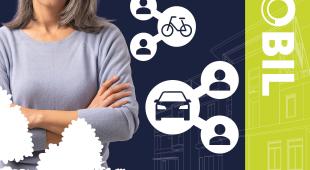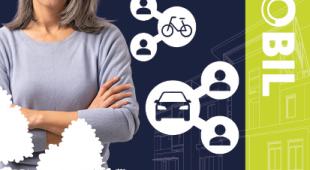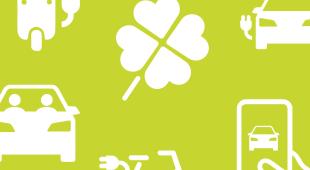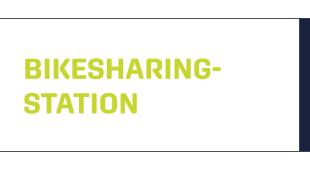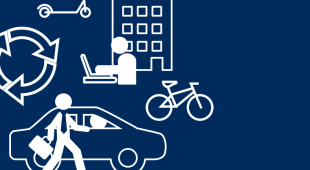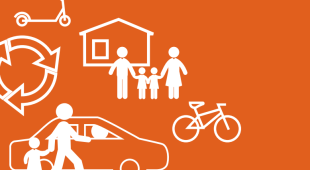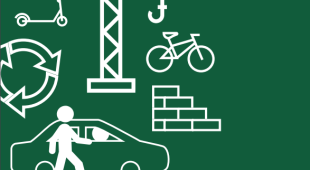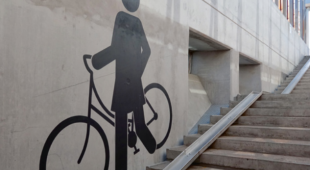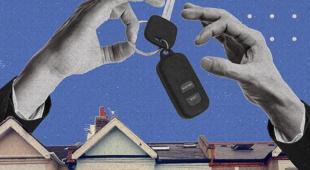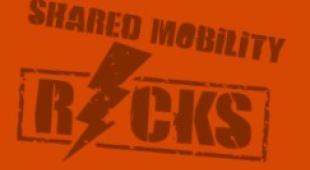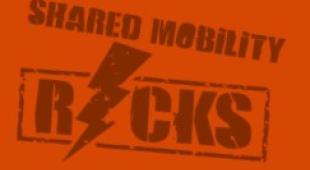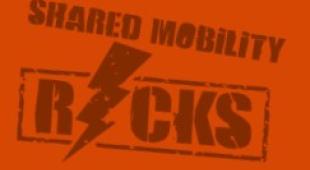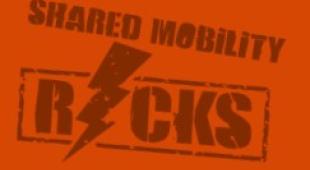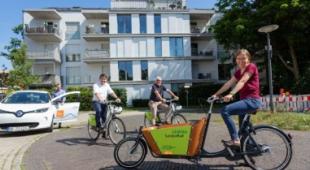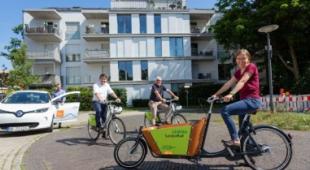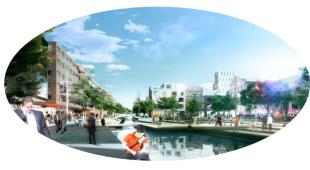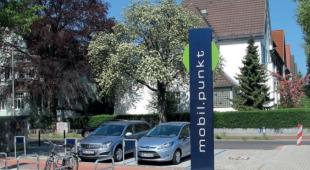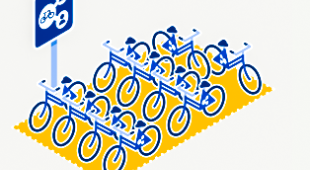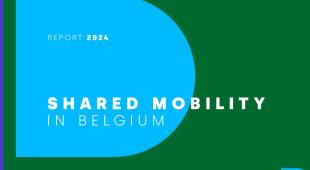Fact Sheets about our Pilot Sites
Fact Sheets Innovative Parking Bylaws | coming soon
Many cities are currently amending their parking bylaws in order to make way for innovative mobility solutions to be able to be integrated in new development areas. However good examples are rare and therefore SHARE-North Squared is taking the step to gather all expertise and provide a one-stop-shop for cities and regions.
Our research team is currently preparing a practical overview for cities and regions on what solutions there are to amend and innovate your parking bylaws.
Stay tuned!
Adaptable Templates for Housing Developers | coming soon
The Free Hanseatic City of Bremen produced adaptable templates for housing developers to be used for ongoing communication of mobility management offers and shared mobility in their developments. Please find here a preview of the templates in German. They are of course adaptable to any language.
We will publish the link to the templates soon.
Until them we can make them available to you upon request:
Please write an email to share-north@bau.bremen.de
Guides on Shared Mobility for Housing Developers
SN² Theory Corner
Need a fresh perspective for your new parking policy or your research? Then you have come to the right place!
In this section, Michael Johansson from Lund University introduces economical, sociological and philosophical theories relevant for shared mobility in a concise and comprehensive way. He also outlines their ramifications for the SN² project.
Stay tuned - more concepts will follow!
Did you know that...
… Braess’s Paradox and Induced Traffic Demand illustrates that individual optimisation can lead to collective inefficiency.
For example: if private car infrastructure is prioritised through direct access roads, shortcuts through neighbourhoods, or internal circulation routes, residents will most certainly choose the fastest routes for themselves. This increases local traffic volumes, especially during peak hours, and reduces the effectiveness of shared mobility options.
What is Braess’s Paradox and induced traffic demand in urban mobility?
In the context of SN², induced demand is particularly relevant when parking is abundant and convenient because this leads to more cars per household, reduced demand for shared mobility services and potentially higher traffic volumes, also when public transport or shared options are available.
Even if shared mobility is introduced later, the built environment has already shaped behavior toward car dependency. Retrofitting becomes costly and less effective.
What is the interplay between Braess’s Paradox and Induced Demand?
Well, these two concepts reinforce each other because Braess’s Paradox warns against over-optimising car routes within developments, and Induced Demand shows that parking and car-centric design will lead to more traffic, even if alternatives exist.
Why does it matter for SN²?
SN² aims to reduce car dependency in housing developments by integrating shared mobility. The Braess's Paradox supports this strategy by showing that reducing parking supply and investing in shared mobility can improve overall transport efficiency.
Multimodal travel options must be attractive and accessible to shift behavior away from private cars. Policy alignment is essential in this respect: if cities continue to prioritise car infrastructure, shared mobility will struggle to compete.
To counteract these dynamics, planners and developers can limit and unbundle parking, charge separately for parking to disincentivise car ownership, designate mobility hubs with car sharing, bike sharing, and e-scooter docks, and ensure real time information and booking systems are accessible to residents.
Did you know that...
… The Egg of Columbus is a metaphor for a brilliant idea or solution that seems simple or obvious after someone has demonstrated it, but was previously considered difficult or impossible.
The story goes that after Christopher Columbus returned from his voyage to the Americas, some critics claimed that his discovery was not particularly impressive. In response, Columbus challenged them to make an egg stand upright on its end. When no one could do it, he gently tapped the egg on the table to flatten one end… and it stood.
The moral of the story? Once a solution is shown, it seems easy. But coming up with the solution in the first place requires creativity and boldness.
What is the Egg of Columbus in urban mobility?
In the context of SN², the Egg of Columbus metaphor can be used to describe:
Innovative planning solutions (e.g., mobility hubs, unbundled parking, digital platforms) that seem obvious in hindsight but require visionary thinking to implement.
Behavioral shifts (e.g., reducing car dependency) that are hard to initiate but become normalised once infrastructure and incentives are in place.
Policy breakthroughs that reframe how we think about mobility equity, sustainability, and urban space.
Why does it matters for SN²?
SN² promotes shared mobility, reduced car dependency, and integrated planning. These ideas often face skepticism or inertia - until they are successfully implemented. Once residents experience the benefits (e.g., fewer cars, more space, better access), the solutions seem 'obvious', just like Columbus’s egg trick. The SN² project helps communities to 'see' what was previously hard to imagine.
The metaphor also supports the idea that pilot projects, living labs, and real-world demonstrations are essential. You cannot just explain shared mobility, you have to demonstrate how it plays out in real life: a mobility hub may seem radical at first, but once residents make use of this solution, it becomes intuitive and desirable.
Did you know that...
… The Downs–Thomson Paradox is a concept in transport economics that states:
"The quality of car travel in a city is directly tied to the quality of public transport. If public transport is poor, car traffic becomes worse even if road capacity is increased."
This paradox highlights that improving road infrastructure alone (e.g. adding lanes or parking) can worsen congestion in the long term, because it encourages more people to drive, especially when public transport is not competitive.
What is the Downs–Thomson Paradox in urban mobility?
In the context of SN², the paradox reveals that expanding parking or making car use more convenient does not solve congestion, but often makes it worse. Neglecting shared mobility and public transport leads to a vicious cycle:
More driving → More congestion → Worse public transport → Even more driving.
Shared mobility (e.g. car sharing, bike sharing, e-scooters) can break this cycle by offering viable alternatives to private car use.
Why does it matter for SN²?
The SN² project aims to reduce car dependency in housing developments by integrating shared mobility. The Downs–Thomson Paradox supports this strategy by showing that reducing parking supply and investing in shared mobility can improve overall transport efficiency.
Multimodal travel options must be attractive and accessible to shift behaviour away from private cars. Policy alignment is essential: if cities continue to prioritise car infrastructure, shared mobility will struggle to compete.
Did you know that...
… In economics, the Free-Rider Problem occurs when individuals benefit from a certain resource, service, or infrastructure without contributing to its actual cost, leading to underfunding or overuse.
It is most common with public goods and contexts such as urban space, more precisely with resources that are non-excludable (you can not prevent people from using them) and non-rivalrous (one person’s use does not reduce availability to others).
What is the Free-Rider Problem in urban mobility?
On-street parking is often free or underpriced, especially in residential areas, which means that car users benefit from publicly funded infrastructure without paying the full cost of land use, maintenance, or environmental impact. At the same time, non-car owners or shared mobility users subsidise this infrastructure through taxes, despite not using it.
Developers are often required to build a minimum number of parking spaces, regardless of actual demand. These costs are passed on to all residents, including those who do not own cars through higher rents or housing prices. Car owners therefore become free riders on the shared cost of parking infrastructure.
Why does it matter for SN²?
The SN² project aims to integrate shared mobility into urban real estate developments to reduce car dependency and promote sustainable travel behaviour.
To succeed, SN² must anticipate and mitigate free-rider behaviour by embedding shared mobility costs into housing contracts (e.g., Living as a Service), creating governance structures that ensure all beneficiaries contribute, and designing incentives and regulations that discourage overuse and underpayment.
Did you know that...
… The Khazzoom–Brookes Postulate argues that increased energy efficiency, rather than reducing overall energy consumption, can paradoxically lead to increased energy use.
This is due to the rebound effect: when energy services become cheaper thanks to efficiency, people tend to use them more or redirect savings to other energy-consuming activities. It therefore challenges the assumption that efficiency alone is sufficient for sustainability.
What is The Khazzoom–Brookes Postulate in urban mobility?
In the context of SN², the postulate warns that:
More efficient cars (e.g. electric or hybrid vehicles) may encourage more driving, not less.
Smaller parking footprints enabled by shared mobility might indirectly increase car use if not paired with demand management.
Technological improvements in shared mobility (e.g. app-based access, vehicle availability) could increase total travel demand if not carefully planned.
Thus, efficiency gains in mobility systems can backfire if they make car use more attractive or accessible without reducing overall demand.
Why does it matter for SN²?
SN² promotes shared mobility, reduced car ownership, and sustainable urban design. The Khazzoom–Brookes Postulate matters because it warns that efficiency alone is not enough. Making private cars more fuel-efficient or electric does not automatically reduce traffic, create more urban space or reduce emissions.
If driving becomes cheaper or more convenient, people may drive more, undermining sustainability goals. We know that shared mobility must be paired with demand management because shared mobility services are often more efficient than private cars. But if they are too cheap or too convenient, they also may replace walking, cycling, or public transport, increasing total vehicle kilometers traveled (VKT).
To avoid negative rebound effects, housing developments must limit parking availability, unbundle parking from housing costs, integrate shared mobility with incentives and pricing, and promote active and public transport as default modes.
Did you know that...
… Ockham’s Razor is a philosophical and methodological principle that suggests:
"The simplest explanation, with the fewest assumptions, is usually the best one."
Named after the 14th-century philosopher William of Ockham, the principle is often paraphrased as:
“Do not multiply entities beyond necessity.”
In practice, it means that when faced with competing hypotheses or solutions, the one that requires the least speculation or complexity is preferred unless evidence suggests otherwise.
What is Ockham's Razor in urban planning?
In the context of shared mobility, parking, and housing development, Ockham’s Razor can be a powerful guiding principle to simplifying mobility systems. Instead of building complex car infrastructure, shared mobility hubs offer a simpler, more efficient solution. And rather than assuming every resident needs a private car, planners can design for actual mobility needs, reducing unnecessary parking and road space.
In relation to evaluating policy options and when choosing between multiple interventions (e.g., subsidies, infrastructure, education), Ockham’s Razor encourages selecting the least complex, most direct solution that achieves the goal.
Finally, when communicating with stakeholders, simple, clear explanations of mobility benefits (e.g., “fewer cars = more space + cleaner air”) are more persuasive and easier to implement than complex models or speculative outcomes.
Why does it matter for SN²?
SN² promotes shared mobility, reduced car dependency, and integrated planning. Instead of building more roads or parking spaces - which seem like obvious fixes but often create more problems - Ockham’s Razor suggests simpler, more elegant solutions that reduce costs, space use, and have environmental impact.
Did you know that...
… Rational Choice Theory (RCT) is a framework from economics and social sciences that assumes individuals make decisions by weighing costs and benefits to maximise their personal utility. In mobility and urban planning, this means people will choose the most convenient, affordable, and time-efficient mode of transport available to them.
The RCT focuses primarily on following key assumptions:
Individuals have clear preferences.
They act consistently to maximise utility.
They respond to incentives and constraints in their environment.
What is the Rational Choice Theory in urban mobility?
In the context of SN², if private car use is cheap and convenient (e.g., free parking, direct road access), RCT predicts that residents will choose to drive, even if shared mobility options exist. If shared mobility is less accessible or perceived as inconvenient, it will be underutilised even if it is more sustainable or socially beneficial.
For instance, someone may choose to drive 5 km to work rather than using alternative, greener, healthier mobility modes, simply because:
Parking is (most certainly) free and guaranteed at work.
The car is of course already owned.
The shared option requires walking or waiting.
This behavior is 'rational' from the individual's perspective, but it can lead to collective inefficiencies (as seen in another concept in our overview: Braess’s Paradox and the Tragedy of the Commons).
Why does it matter for SN²?
To align individual rational choices with collective sustainability goals, planners can:
Change the incentive structure, e.g. charge for parking, unbundle parking from housing costs and offer shared mobility modes.
Improve the utility of shared mobility, e.g. ensure reliability, accessibility, and visibility.
Make sustainable choices the rational choice, e.g. by designing walkable neighbourhoods, place mobility hubs at central, visible locations, and limit car access to certain zones.
Did you know that...
… The Tragedy of the Commons is a concept from economics and ecology that describes how individuals, acting in their self-interest, can overuse and deplete a shared resource even though it is against everyone’s long term interest.
Here is a classical example: in a shared pasture, if each farmer adds more animals to maximise personal gain, the pasture becomes overgrased and eventually unusable for all.
What is the Tragedy of the Commons in urban mobility?
In the context of SN², parking space for example is a shared (or privately owned) and finite resource, especially in dense residential areas. Why? Because each resident wants convenient, free, and abundant parking. If everyone owns and uses a private car, the demand for parking exceeds supply.
This in turn leads to overcrowded streets, illegal or unsafe parking, reduced space for pedestrians, cyclists, and shared mobility services, and most certainly conflicts between residents and visitors. Even if shared mobility options are available, the perceived convenience of private cars can lead to underuse of sustainable alternatives. This undermines the system’s efficiency and equity.
Why does it matter for SN²?
Shared mobility can mitigate the tragedy by:
Reducing the number of vehicles needed per household.
Optimising space usage (fewer parked cars, more dynamic use).
Encouraging collective responsibility for mobility resources.
But this only works if the system is well-managed and accessible, if residents trust and use shared options, and of course if infrastructure and incentives support modal shift.
So, to prevent overuse and degradation of mobility resources in housing developments, we should limit private parking and prioritise shared mobility, introduce parking pricing or permits to regulate demand, designate space for shared vehicles, and educate residents on the benefits of shared mobility.
Research and Reports
Links and Articles from the SN²-Partners
Bicycle Parking Guide - Principles and guidance for good bicycle parking (in Norwegian)
Urban planning regulations Mechelen (in Dutch).
Bicycle Parking article (in Norwegian).
Guideline from 2020 on implementing shared mobility in housing developments in the Flanders Region (in Dutch).
Guideline from 2021 on implementing shared mobility in housing developments in the Brussels Capital Region (in Dutch).
Guideline from 2023 on implementing shared mobility in social housing (in Dutch).
Guideline on parking policies and shared mobility (in Dutch).
Inspiration from SHARE-North
The partners in our forgoing project, Interreg SHARE-North, develop a set of shared mobility icons. These icons help to increase the recognition of shared mobility and mobility hubs. They may be used in signage, at mobility hubs, on websites and in information packages. The icons are free for sharing and have been made available in Noun Project, a free icon gallery. Our icons are becoming iconic: they are increasingly used across Europe!
You can download the entire set of icons for free:
Please share any edited icons with us well, we would love to see what you come up with!
SHARE-North's iconic shared mobility icons.
The SHARE-North project consortium has produced a number of video highlighting shared mobility options and their benefits. You can check them here on YouTube as a source of inspiration!
